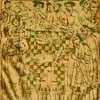Events relating to england
Harold, hurrying south to confront the Normans after his victory at Stamford Bridge, is defeated and killed at Hastings
William the Conqueror (William I) is crowned on Christmas Day at Westminster - giving the new abbey church two coronations and a royal funeral in its first year
Work begins on the story of the Norman conquest, narrated in embroidery in the Bayeux tapestry
Norman earls are given territories on the marches of Wales, with the specific task of raiding their neighbours
On the death of his father, William the Conqueror, William II becomes king of England
The Domesday Book provides the Normans with an inventory of England

Work begins on a new cathedral in Durham, which will become an outstanding example of Norman (or Romanesque) architecture
On the death of his brother, William II, Henry I becomes king of England
The White Ship strikes a rock off the Cherbourg peninsula drowning William the Aetheling, heir to the English throne
On the death of Henry I, his nephew Stephen moves quickly to keep Henry's daughter Matilda off the English throne
Gilbert of Hastings, an English priest, becomes bishop of the recovered see of Lisbon - the first of many such links between England and Portugal
Henry II, coming to the throne of England, is king or feudal overlord of an unbroken swathe of territory from the Tweed to the Pyrenees
Thomas Becket, Lord Chancellor to Henry II, is forced by the king to accept the vacant post of archbishop of Canterbury
Thomas Becket, having offended the king by his firm stand as archbishop of Canterbury, flees to a monastery near Paris

The English exchequer grows in importance under Henry II, taking its name from the table on which financial calculations are made
Henry II arranges for the archbishop of York to crown his son, the 'Young King', as a joint ruler
Thomas Becket, in France, suspends the English bishops who have participated in the coronation of the 'Young King'
After an apparent reconciliation with Henry II, Thomas Becket leaves France and returns to Canterbury
Four knights, acting on an unguarded hint from Henry II, murder Thomas Becket on December 29 in his cathedral at Canterbury
The English king, Henry II, acknowledges Rhys ap Gruffydd as the lord of south Wales
Henry II, the king of England, summons the Irish and Norman lords to do homage to him in Dublin

The Gothic style is first seen in Britain in the new east end of Canterbury cathedral

Construction begins on London Bridge, the first stone bridge to be built across a tidal waterway
The first known eisteddfod is held during Christmas festivities at Rhys ap Gruffydd's court in Cardigan castle
The English king Henry II is succeeded by his third son as Richard I










